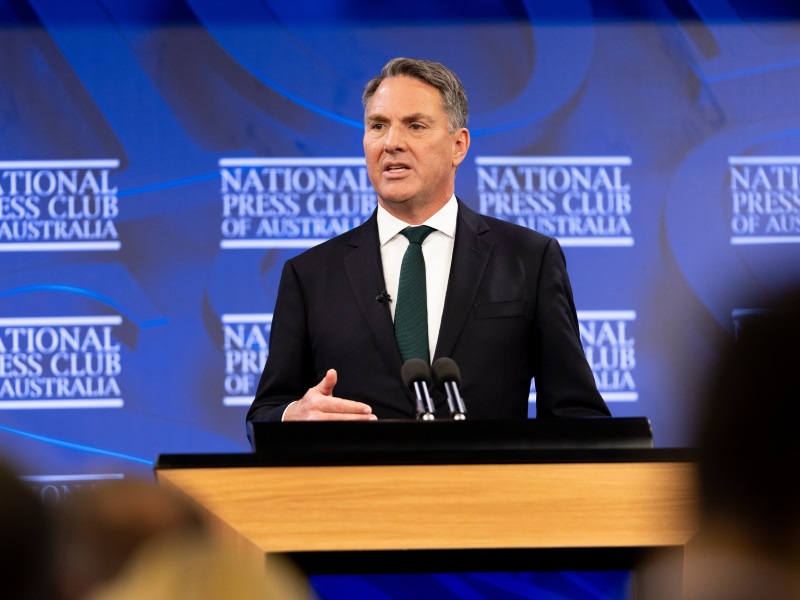Defence will spend up to $36 billion on space, cyber, and electronic warfare capabilities over the next decade, according to the federal government’s new integrated investment program.
The integrated investment program (IIP) was released alongside the National Defence Strategy at the National Press Club by Defence minister Richard Marles on Wednesday. The IIP represents planned Defence spending worth between $330 billion and $420 billion.
It also includes up to an additional $400 million for the Advanced Strategic Capabilities Accelerator (ASCA) and $1.1 billion for Australian drone and counter-drone capabilities.

Funding in the IIP is given over a range to account for projects that are classified, in early stages of development, or are liable to private sector pricing changes.
To fund the IIP, the government reprioritised $72.8 billion worth of programs over the next decade and topped up the Defence budget by an additional $50.3 billion.
Planned cyber investments range between $15 billion and $20 billion, space investments between $9 billion and $12 billion, and planned electronic warfare investments of $2.7 billion to $3.7 billion. However, only $4.5 billion of this spend has been approved so far.
Planned investment figures represents an uplift when compared to the funding outlined in the Force Structure Plan 2020. At the time, $7 billion was to be invested in the space domain and $15 billion in the information and cyber domain over the decade.
Mr Marles told the National Press Club that “cyber is now a critical domain of conflict”. Included in the investments is the previously announced REDSPICE program, delivery of “an enhanced deployable defensive cyber operations capability”, and improvements to “warfighting cyber capabilities”.
“Through both the ADF and the ASD, Australia genuinely above our weight in this domain… [the investment will] ensure that Australia builds this capability such that we remain at the forefront of developments in the cyber domain,” Mr Marles said.
Space capability investments are split across satellite communication, space sensors, and space control. The is includes “measures to enhance Defence’s space control capability to deny attempts to interfere with, or attack, Australia’s use of the space domain”.
The IIP document only outlines the previously announced plans to deliver “a sovereign-controlled Australian Communications system capability over the Indo-Pacific” as well as the Deep-space Advanced Radar Capability being developed with the United States and the United Kingdom.
The National Defence Strategy lists six innovation, science, and technology priorities: long-range fires, hypersonics, directed energy, information warfare, trusted autonomy, and quantum technology.
While no explicit funding commitments are outlined for quantum technology projects, it is understood that the funding falls within the allocation to space and cyber capabilities. As quantum technologies is also a priority under AUKUS Pillar II, work will also be developed through ASCA.
ASCA, which is intended to improve Defence-industry capability development and streamline pathways to acquisition, was launched in mid-2023 with a budget of $3.4 billion. However, the IIP now lists the ASCA budget as being between $3.6 billion and $3.8 billion.
$4.3 billion to $5.3 billion will also be invested in “the development and acquisition of un-crewed aerial systems”, including through the MQ-28A Ghost Bat program and other co-development programs with Australian industry.
Subsea warfare and un-crewed maritime vehicles will see a development and acquisition investment of between $5.2 billion and $7.2 billion, including through AUKUS Pillar II. The funding also covers the ongoing Ghost Shark program.
Defence Industry minister Pat Conroy said in a statement that the Integrated Investment Plan “deliberately reshapes the ADF’s acquisition program to ensure it has the critical capabilities needed for the next decade and beyond”.
“This is a record investment in defence capability and an investment in a future made in Australia, which will not only make the country safer, but also deliver dividends for industry and jobs for hard-working Australians,” Mr Conroy said.
“This fully funded plan ensures a continuous pipeline of investment that underscores the Albanese Government’s unwavering commitment to developing Australia’s sovereign defence industry.”
Do you know more? Contact James Riley via Email.

